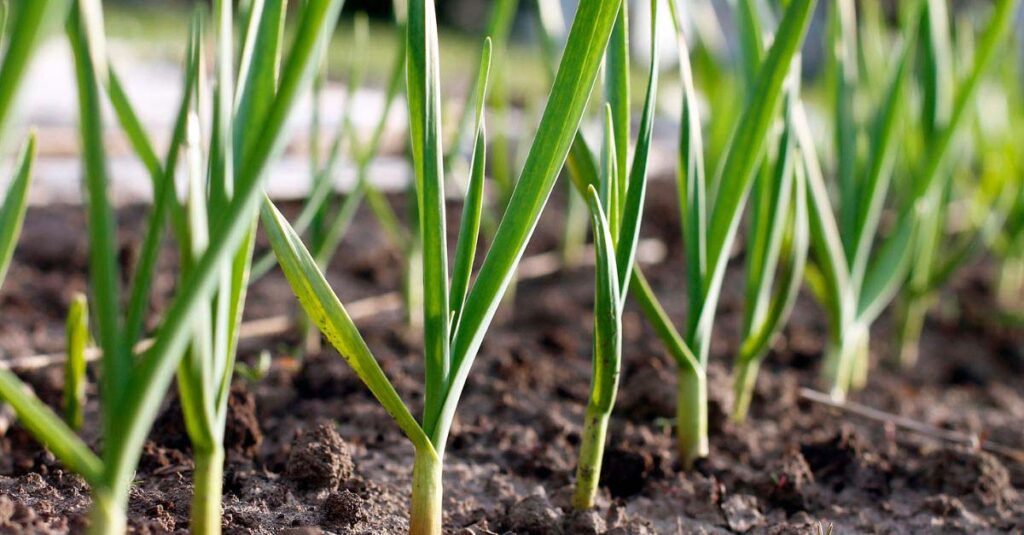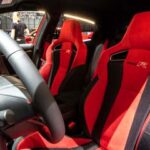Garlic, a versatile and flavorful herb, has captivated the culinary world for centuries. Understanding the Garlic growing stages is essential for successful cultivation, whether you’re a seasoned gardener or a novice with a green thumb.
Garlic undergoes distinct phases in its growth cycle, from planting cloves to harvesting bulbs. Each stage demands specific care and attention, making it crucial for growers to grasp the nuances of the process.
Appreciating these stages is paramount for achieving a bountiful garlic harvest. It allows growers to tailor their approach, providing the optimal conditions for each developmental milestone. This knowledge ensures that the garlic receives the right nutrients, water, and care at every step, ultimately enhancing the quality and quantity of the yield.
Pre-planting garlic growing stages
In the pre-planting stage, soil preparation and testing play a crucial role. Farmers till the soil to create a suitable environment for seeds. They also conduct soil tests to determine nutrient levels, ensuring optimal conditions for plant growth.
Seed selection and preparation are essential steps in this stage. Farmers carefully choose seeds based on factors like climate and soil type. They may treat seeds with protective coatings or presoak them to enhance germination.
Timing of planting is a key aspect of successful agriculture. Farmers consider factors such as weather patterns and seasonal variations to determine the most favorable time for planting. Planting at the right time maximizes the chances of a bountiful harvest.
Germination Stage – Garlic growing stages
During the germination stage, specific conditions are crucial for successful sprouting. Adequate moisture, oxygen, and a suitable temperature range are essential factors. Seeds absorb water, activating enzymes that kickstart the germination process.
The size of the germination duration varies among plant species. Some seeds may sprout in a matter of days, while others may take weeks. It depends on factors such as seed type, environmental conditions, and the presence of inhibitors.
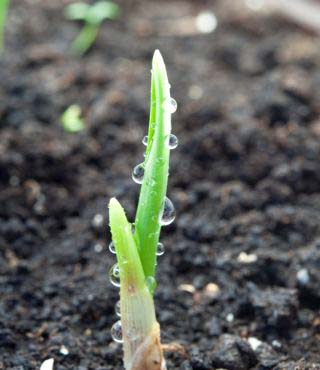
Proper watering is vital for successful germination. The soil should be consistently moist but not waterlogged, ensuring that the seed receives sufficient hydration for growth. Water helps transport nutrients to the emerging seedling.
Fertilization plays a key role during germination. Seeds contain enough nutrients for the initial stages, but as the seedling develops, it requires external nourishment. A balanced fertilizer provides essential nutrients, promoting healthy root and shoot development.
Garlic Growing Stages
Garlic begins its journey through germination, where planted cloves start developing roots and shoots. During this stage, the cloves absorb moisture, initiating the sprouting process. The emergence of tiny green shoots marks the onset of early growth.
The Role of Temperature and Watering
Temperature plays a pivotal role in garlic growth. Optimal temperatures ranging between 50 to 70°F (10 to 21°C) foster robust development. Adequate watering is crucial, ensuring the soil remains consistently moist but not waterlogged. Garlic plants thrive when provided with a well-balanced environment.
Common Challenges at this Stage
Despite the simplicity of garlic cultivation, challenges may arise during germination and early growth. Inconsistent watering can impede the development of garlic cloves, leading to stunted growth. Additionally, extreme temperatures, either too hot or too cold, can adversely affect the germination process and hinder the plant’s progress.
Vegetative Garlic growing stages
During the vegetative stage of garlic, the primary focus is on the growth and development of its leaves. This stage is crucial for establishing a robust foundation for the garlic plant. Adequate sunlight is essential, as it fuels the process of photosynthesis, enabling the leaves to produce the energy needed for growth.
Weed control plays a pivotal role during this stage. Unwanted weeds can compete with garlic plants for essential nutrients, water, and sunlight. Regular weeding is necessary to ensure that garlic receives the full benefit of these resources, promoting healthier and more vigorous growth.
Fertilization is another key aspect of the vegetative stage. Garlic plants require nutrients such as nitrogen, phosphorus, and potassium to thrive. Applying a balanced fertilizer helps provide these essential elements, supporting the development of strong and vibrant leaves.
Proper watering is crucial for garlic during the vegetative stage. The soil should be held always sticky but not waterlogged. Garlic plants prefer well-draining soil to prevent waterlogged conditions that may lead to root rot. Adequate moisture supports the absorption of nutrients and contributes to the overall health and vigor of the garlic plant.
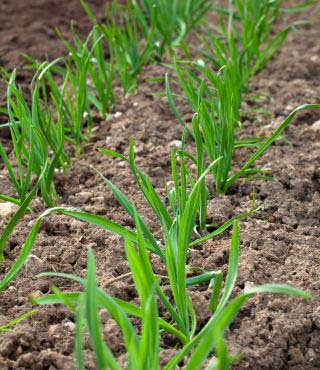
Vegetative Growth – Garlic growing stages
Vegetative growth is a crucial phase in a plant’s life cycle where it focuses on developing leaves, stems, and roots. Ensuring proper fertilization and meeting nutrient requirements is essential for robust vegetative growth. Plants need key nutrients like nitrogen, phosphorus, and potassium during this stage.
To support healthy growth, regularly provide a balanced fertilizer that contains these essential elements. Nitrogen aids in leaf development, phosphorus supports root growth, and potassium contributes to overall plant vigor. A well-fed plant is better equipped to withstand environmental stresses and produce a higher yield.
Effective weed and pest management are also vital components of promoting vegetative growth. Weeds compete with plants for nutrients and sunlight, hindering their development. Regularly inspect the growing area and promptly remove any weeds to create an optimal environment for plant growth.
Pests can pose a significant threat during the vegetative phase. Actively monitor for signs of infestation, such as wilting leaves or unusual discoloration. Employ natural predators or environmentally friendly pesticides to control pests and minimize damage to the plants.
By maintaining a proactive approach to fertilization and nutrient management while effectively managing weeds and pests, you can foster a healthy vegetative growth phase for your plants. This sets the foundation for strong, productive crops as the plants progress through their life cycle.
Bulb Formation Garlic growing stages
The bulb formation stage is a crucial phase in the life cycle of plants, marked by significant changes in their growth and development. During this period, the plant focuses its energy on the formation of bulbs, which are essential storage organs.
Proper nutrition plays a pivotal role in supporting the plant through this Garlic growing stages. Providing the right balance of nutrients ensures robust bulb development. Nutrient-rich soil encourages the plant to allocate resources efficiently, promoting the growth of healthy bulbs.
Watering is equally vital during the bulb formation stage. Adequate and timely watering prevents dehydration and supports the metabolic processes involved in bulb development. Consistent moisture levels contribute to the plant’s overall health and vitality.
Importantly, the significance of proper nutrition and watering extends beyond immediate growth. These practices lay the foundation for the plant’s future, influencing its ability to produce vibrant flowers or yield quality crops.
Observing signs of bulb maturity is key to determining the optimal harvest time. Mature bulbs exhibit specific characteristics, such as changes in color, size, and texture. Monitoring these indicators ensures that the plant has completed its growth cycle and that the bulbs are ready for harvest.
Harvesting Garlic – Garlic growing stages
Harvesting garlic is a rewarding endeavor that requires careful attention to ensure maximum flavor and storage longevity.

Knowing When Garlic is Ready to Harvest
- Keep a close eye on the garlic plant’s leaves. When the lower leaves turn yellow and start to fade, it’s a sign that the garlic bulbs are growing.
- Garlic scapes are the curly flower stalks that emerge from the plant. Harvest garlic before the scapes straighten, as this indicates optimal bulb development.
- Gently unearth a bulb to inspect its size and wrapper layers. Harvest when the bulbs have divided into distinct cloves, and the wrappers are papery but still intact.
Harvesting Techniques for Maximum Flavor and Storage
- To prevent damage to the bulbs, carefully loosen the soil around the garlic using a digging fork. Insert the fork beneath the bulbs and lift them gently from the ground.
- Once the garlic bulbs are unearthed, shake off excess soil without removing the wrappers. Be peaceful to avoid bruising or trimming the bulbs.
- Place the garlic in a well-ventilated, shaded area to cure for about two to three weeks. This allows the bulbs to dry, enhancing their flavor and improving storage quality.
- After curing, trim the dried tops of the garlic bulbs, leaving about an inch of stem. This helps to prevent mold growth and prolongs storage life.
- Store the cured garlic bulbs in a cool, dry place with good air circulation. Proper storage ensures that your harvested garlic maintains its flavor and quality for an extended period.
By following these simple and active harvesting techniques, you can enjoy the full flavor of your homegrown garlic while ensuring its long-term storage success.
Harvesting Stage – Garlic growing stages
The Harvesting Garlic growing stages is a crucial phase in agriculture, demanding careful attention to timing, methods, and storage techniques.
Timing is pivotal in the harvest. Farmers must gauge the optimal moment when crops reach peak maturity. This ensures maximum yield and quality. Each crop has its unique indicators, such as color, size, or texture, signaling the ideal harvest window.
Various methods are employed for harvesting. Hand harvesting involves manual labor, suitable for delicate crops like fruits. Mechanical harvesting, on the other hand, employs machinery for efficiency in large-scale operations. Combines, for instance, are commonly used for grain crops, streamlining the process.
Proper curing is imperative post-harvest. It involves allowing harvested crops to dry or mature further under controlled conditions. This step is critical for crops like tobacco or certain fruits. The right curing method preserves flavor, texture, and nutritional value.
Storage techniques play a pivotal role in maintaining the quality of harvested produce. Appropriate storage conditions vary by crop but typically involve regulating temperature, humidity, and ventilation. Root vegetables often benefit from cool, dark storage, while fruits might require refrigeration.
Curing and Storing Garlic
Curing Garlic growing stages are crucial steps to ensure its optimal flavor and longevity. Let’s delve into the significance of curing and the proper conditions for storage.
Curing, the process of drying garlic after harvesting is essential for enhancing its flavor and promoting long-term storage. This method allows the garlic bulbs to develop a protective layer, known as the papery skin, which shields them from moisture and external elements. Effective curing contributes to the garlic’s overall quality, making it more flavorful when used in various culinary dishes.
Proper storage conditions are key to maintaining the freshness and flavor of cured garlic. Once cured, store garlic bulbs in a cool, dry place with good air circulation. Choose a location with temperatures ranging from 60 to 65°F (15 to 18°C). Avoid exposing garlic to direct sunlight, as this can lead to sprouting and deterioration of its quality.
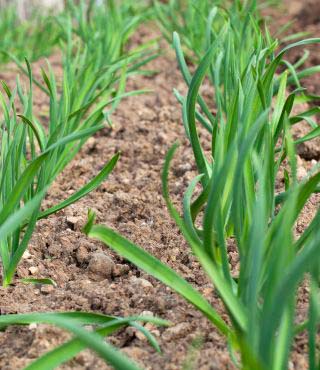
For extended storage, consider hanging garlic bulbs in mesh bags or braiding them together and hanging them in a well-ventilated area. This method not only maximizes air circulation but also prevents mold growth. Alternatively, storing garlic in a breathable container like a mesh basket or a loosely woven bag helps maintain the necessary airflow while keeping the bulbs in optimal condition.
By giving due attention to the curing process and adhering to proper storage conditions, you can ensure that your garlic stays flavorful and retains its quality for an extended period. So, take these simple yet effective steps to enjoy the rich taste of garlic in your culinary endeavors.
Troubleshooting Common Issues
Dealing with Pests and Diseases
- Examine your plants regularly for any signs of pests or diseases. Look for unusual spots, discoloration, or wilting.
- If you spot any issues, separate the affected plants from healthy ones to prevent the problem from spreading.
- Consider using natural remedies like neem oil or insecticidal soap to control pests. These are effective and environmentally friendly.
- Trim away infected or damaged parts of the plant. This helps prevent the spread of diseases and encourages new, healthy growth.
- Keep your gardening tools and containers clean to avoid introducing pests. Regularly remove debris and fallen leaves around your plants.
Addressing Growth Irregularities
- Ensure your plants are receiving the right amount of sunlight. Adjust their placement if needed to provide adequate light for optimal growth.
- Overwatering or underwatering can cause growth irregularities. Monitor soil moisture and adjust your watering routine accordingly.
- Check for nutrient deficiencies by observing leaf color and growth patterns. Provide the necessary fertilizers to balance nutrient levels.
- Plants need proper spacing for healthy growth. Ensure they have enough room to develop without overcrowding.
- Extreme temperatures can affect plant growth. Protect your plants from harsh weather conditions or relocate them if necessary.
By staying vigilant, taking prompt action, and addressing these common issues, you’ll help your plants thrive and maintain a healthy garden.
FAQ
What is the reproductive cycle of garlic?
The reproductive cycle of garlic begins with bulb division. In fall, each bulb separates into cloves. Come spring, these cloves sprout into green shoots. As the shoots grow, they form garlic bulbs. By summer, the bulbs mature and divide, restarting the cycle. This process ensures garlic’s propagation and is crucial for its cultivation.
What should garlic look like when growing?
When growing, garlic should display vibrant green shoots emerging from the soil. The leaves should be sturdy and upright, with no signs of wilting or yellowing. Bulbs beneath the soil should be well-formed, plump, and covered in a protective papery skin. Ensure there are no visible signs of mold, discoloration, or softness.
Healthy garlic plants exhibit uniform growth and a robust appearance. Regularly inspect for pests and diseases, addressing any issues promptly. Overall, thriving garlic growing stages present a vigorous and uniform growth pattern, showcasing its potential for a successful harvest.
What is the best fertilizer for garlic?
The best fertilizer for garlic is well-balanced, with equal parts nitrogen, phosphorus, and potassium. Choose a fertilizer labeled specifically for vegetables or garlic. A balanced 10-10-10 or 8-8-8 mix is suitable. Ensure the soil pH is between 6.0 and 7.5 for optimal garlic growth.
Apply the fertilizer in early spring before planting and again when the plants start forming bulbs. Follow the recommended application rates on the fertilizer package. This helps provide essential nutrients for robust garlic development, ensuring a healthy crop.
How long does garlic last?
Garlic typically lasts three to five months when stored in a cool, dry place with good air circulation. Check for firm cloves and avoid sprouting or mold. Once peeled, use within a week for optimal freshness. Proper storage ensures garlic retains its robust flavor and nutritional benefits.
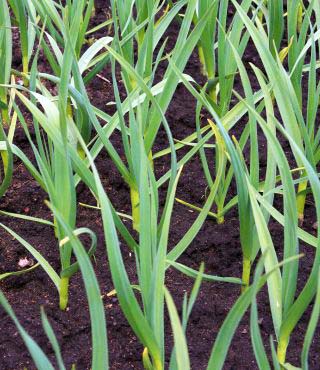
Conclusion
Cultivating garlic at home offers a rewarding journey from planting to harvest. We explored the essential Garlic growing stages: selecting quality cloves, preparing the soil, and providing optimal care. By following these outlined steps, readers can embark on a fulfilling gardening experience. The satisfaction derived from nurturing garlic bulbs as they develop into vibrant plants is unparalleled.
Growers will appreciate the convenience of having fresh, flavorful garlic at their fingertips. Harvesting your garlic not only ensures a supply of chemical-free produce but also imparts a sense of accomplishment. From the earthy aroma of the soil to the joy of witnessing each green shoot emerge, the journey is as enriching as the end result.
